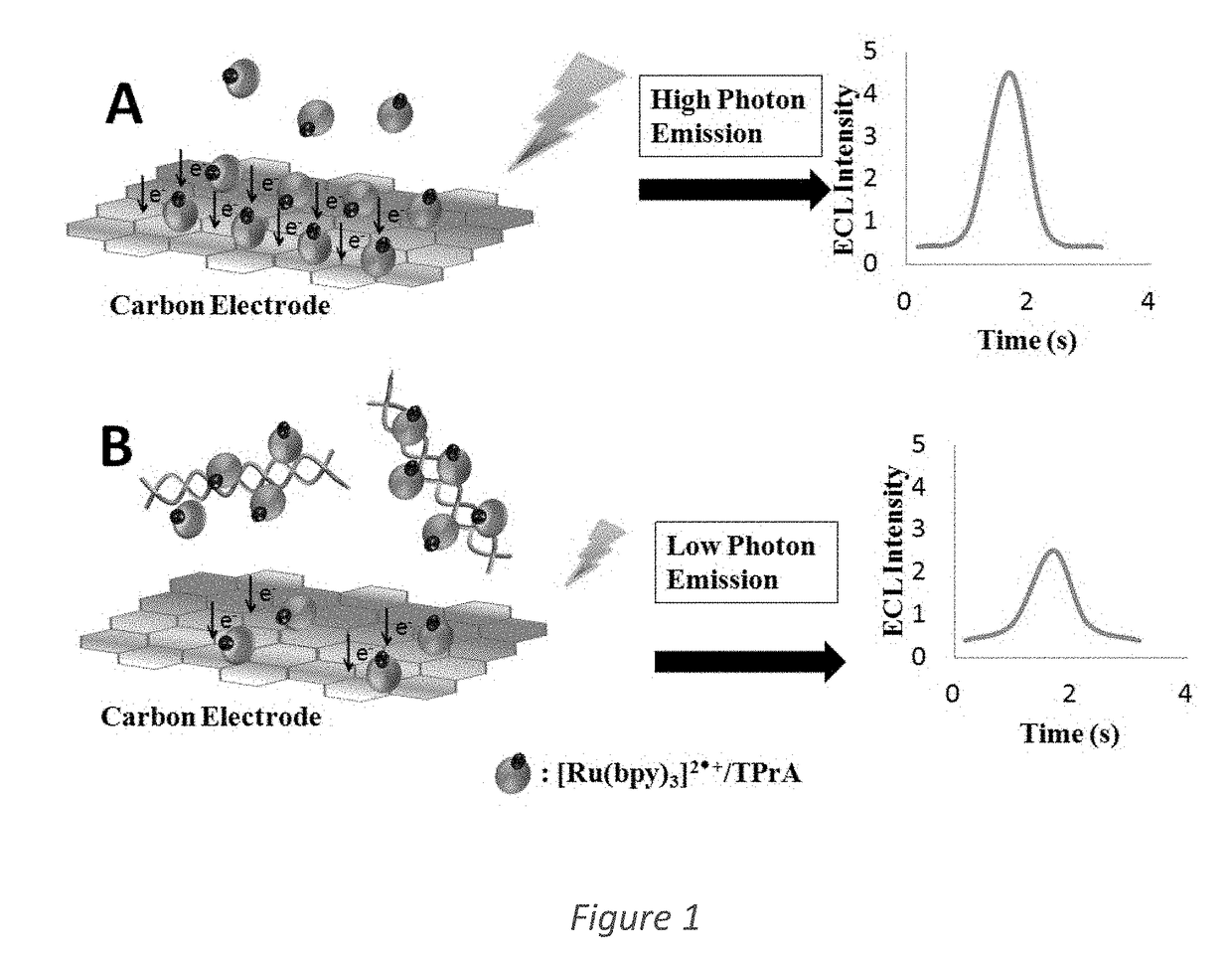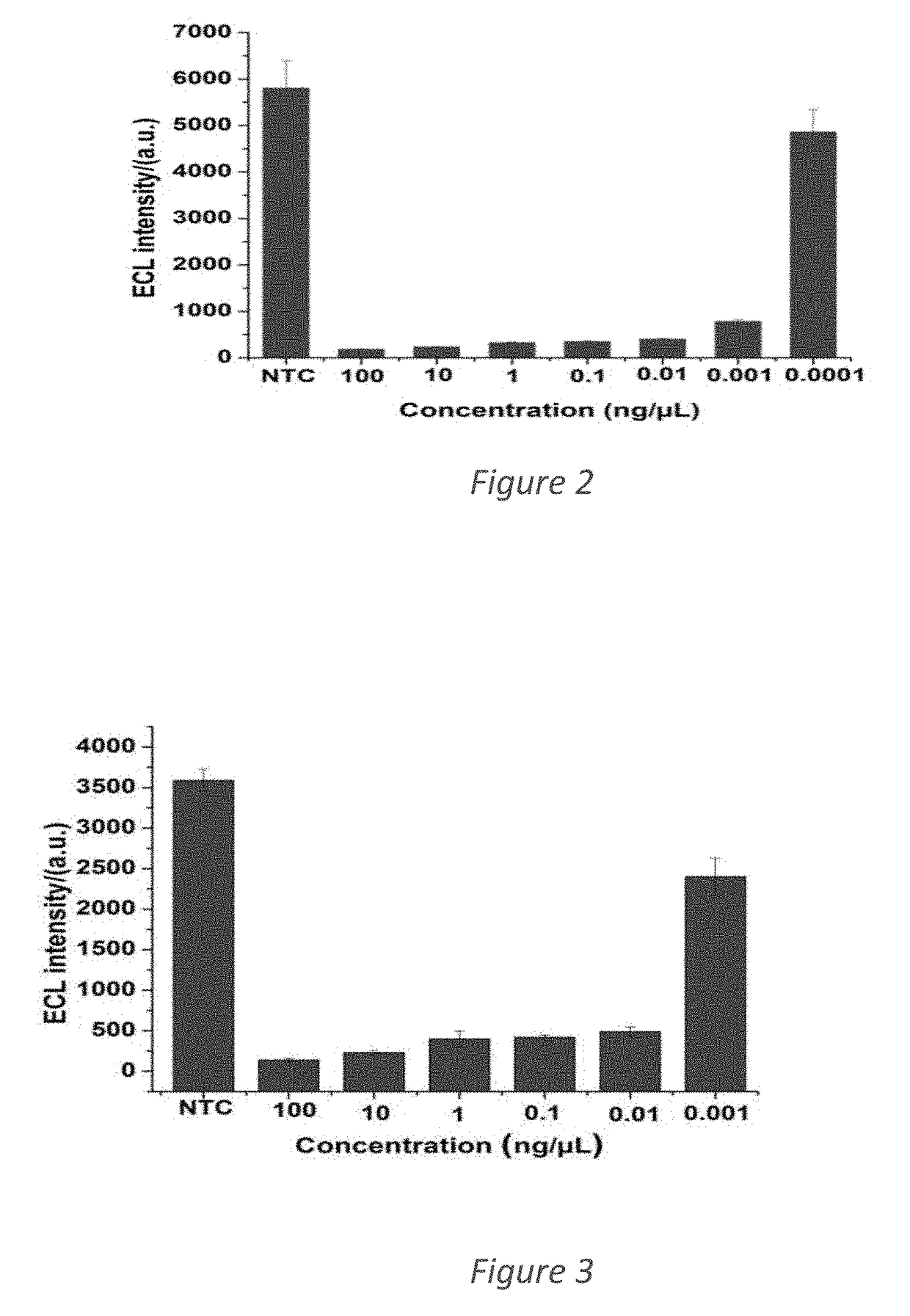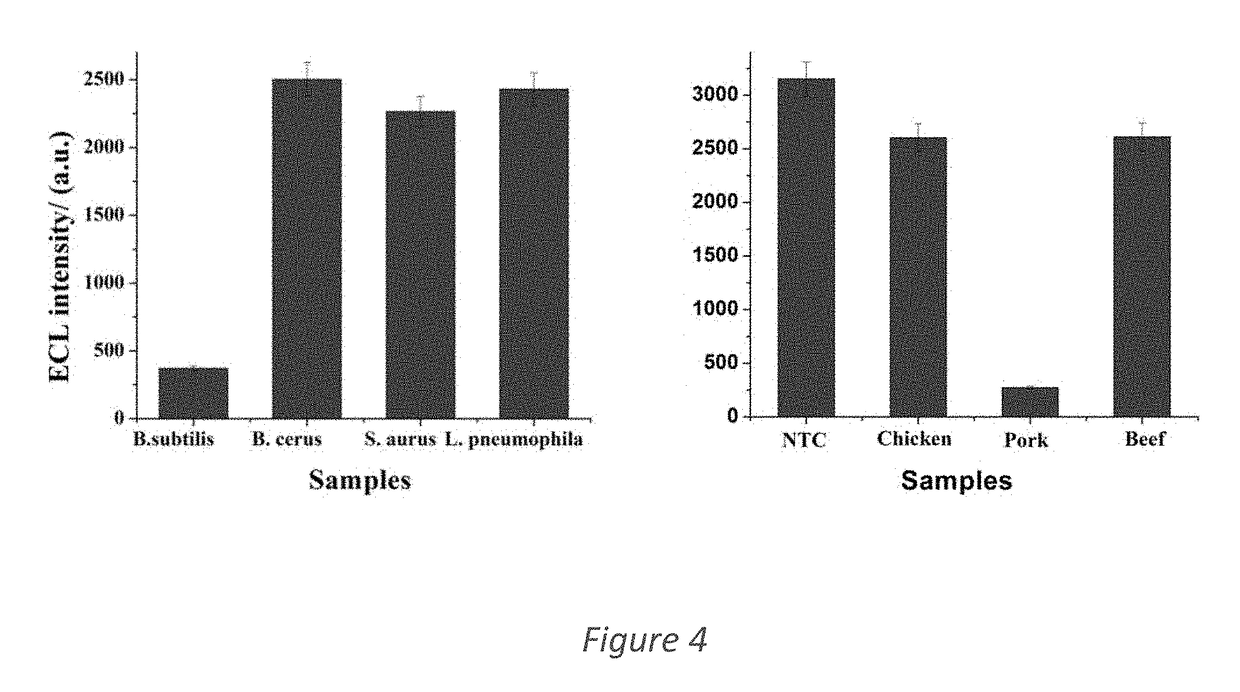System and Method for Immobilization free electrochemiluminescence DNA detection using a luminophore dye for multi-species detection
a luminophore dye and free electrochemiluminescence technology, applied in the field of new target dna detection methods, can solve the problems of difficult nucleic acid detection assays, bulky and costly equipment, and take a long time to complete the whole detection process
- Summary
- Abstract
- Description
- Claims
- Application Information
AI Technical Summary
Benefits of technology
Problems solved by technology
Method used
Image
Examples
example 1
[0039]DNA Preparation and Collection for Sus scrofa Species
[0040]Pork meat samples were collected from different markets with different origins and following genomic DNA extraction with the DNeasy tissue kit (Qiagen, Germany), the purified DNA concentrations were measured with a NanoPhotometer (Implen GmbH, Germany) and these samples were then stored at −20° C. until further use.
[0041]Primers and Preparation of LAMP Reactions for Sus scrofa Species
[0042]Optimized primer set for Sus scrofa which comprise regions of the Cytochrome b gene (GenBank accession #AFO34253.1) was used in LAMP reaction. Table 1 below gives the details of those optimized primers identified as SEQ ID NO:1 to SEQ ID NO:6. LAMP reactions were carried out at temperatures ranging from 60° C. to 65° C. and for different time periods of up to 60 min (ST 1 in Supplementary information). The total volume of the LAMP reaction was 25 mL and 5 mL of gDNA template was added to reaction. To avoid evaporation, 10 mL of miner...
example 2
[0046]DNA Preparation and Collection for Bacillus subtilis Species
[0047]The Bacillus subtilis genomic DNA was obtained from the Leibniz Institute (DSMZ, Germany) and stored at −20° C.
[0048]Primers and Preparation of LAMP Reactions for Bacillus subtilis Species
[0049]Optimized primer set for Bacillus subtilis which comprise regions of the rpoB gene (GenBank accession #NC_000964.3) was used in LAMP reaction. Table 2 below gives the details of those optimized primers identified as SEQ ID NO:7 to SEQ ID NO:12. LAMP reactions were carried out in similar manner including similar temperature and time as mentioned in example 1 above.
TABLE 2Primer detailsSEQTypeSequenceSEQ IDForward5′-GAAGAGGATATGCCTTACCTTC-3′NO. 7outerSEQ IDReverse5′-CGACAGATACACGGTTATCAA-3′NO. 8outerSEQ IDForward5′-NO. 9innerGGTAACGAGCGGCCATACCTACCATCACGTATGAACATCG-3′SEQ IDReverse5′-TGGCATTCACATTGCATCTCCTCCGGCTNO. 10innerTCTTCAAGTGTT-3′SEQ IDLoop5′-CATGTGAAGTTCCAATACCTGC-3′NO. 11forwardSEQ IDLoop5′-GCGAGAAGAGGATGTCTGG-3′NO....
example 3
Checking Specificity of the Lamp-ECL System
[0053]To check for species cross-reactivity, the LAMP assays for both species namely Sus scrofa and Bacillus subtilis were tested with genomic DNA input from various other species. As seen in FIG. 4 and tables 3 and 4 below, it was observed that in both cases the loop primers did not cross-react with other species' genomic DNA. A DNA template input concentration of 10 pg / mL was used for all cross-reactivity experiments.
TABLE 3Detectionof DNA withAverage ECLSamplepork-specificintensityno.Sample typeSpecies as labelledLAMP-ECL(a.u.)SD1Spiced pork cubesSus scrofaYes35748.322Pork mince with bean pasteSus scrofaYes4489.933Chopped pork & hamSus scrofaYes368.5032.274Chao San Si (pork &Sus scrofaYes54137.26bamboo shoot)5Mutton luncheon withGallus gallus,No1821.50111.94chickenPuffinus tenuirostris6Corned beefBos taurusNo1802.5240.8697Chicken luncheon meatGallus gallusNo2247.20321.388Beef loafBos taurusNo1310.2272.759Chicken luncheon meatGallus gallu...
PUM
| Property | Measurement | Unit |
|---|---|---|
| Acidity | aaaaa | aaaaa |
| Length | aaaaa | aaaaa |
| Length | aaaaa | aaaaa |
Abstract
Description
Claims
Application Information
 Login to View More
Login to View More - R&D
- Intellectual Property
- Life Sciences
- Materials
- Tech Scout
- Unparalleled Data Quality
- Higher Quality Content
- 60% Fewer Hallucinations
Browse by: Latest US Patents, China's latest patents, Technical Efficacy Thesaurus, Application Domain, Technology Topic, Popular Technical Reports.
© 2025 PatSnap. All rights reserved.Legal|Privacy policy|Modern Slavery Act Transparency Statement|Sitemap|About US| Contact US: help@patsnap.com



